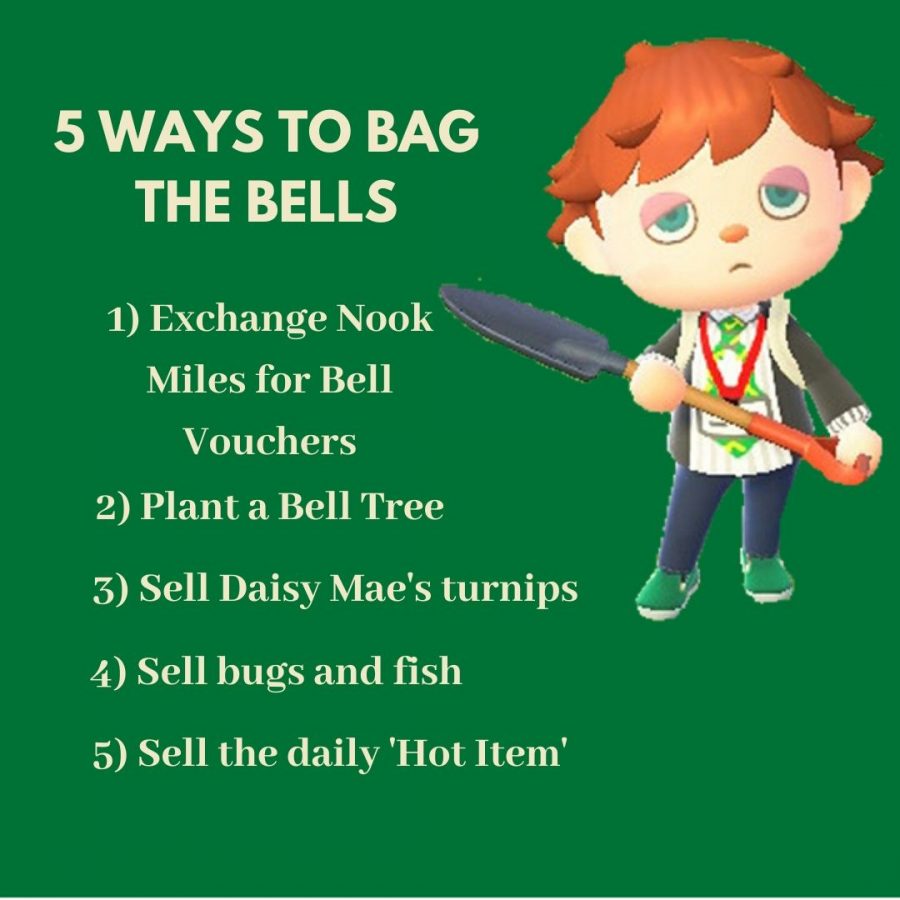A guide to wealth in Animal Crossing: New Horizons
Animal Crossing: New Horizons is the popular new addition to the beloved Animal Crossing video game franchise. Within the game, bells are used as currency, and it can be difficult to earn enough bells to pay in-game debts. The following article written by Azul Lin explains how you can earn bells in New Horizons. *The character icon pictured is courtesy of Animal Crossing: New Horizons and Azul Lin.
May 2, 2020
*The following article has been written as an instructive guide to aid players on the recently released game Animal Crossing: New Horizons. If you want to read more about the new release, please check out our review on the game.
Wouldn’t you agree that the perfect start to your island getaway is being reminded of how much the trip cost the moment you arrive? For many, it is likely the opposite, but in the eyes of Tom Nook, the island manager, it is the best way to motivate you to start working at collecting one of the main currencies of Animal Crossing: Nook Miles. Those are easy enough to collect, considering you have objectives that tell you how to acquire them, but Tom Nook’s debts look deceptively easy to pay off. Once you have paid off your vacation, the debts that come afterwards demand the harder of the two to acquire: bells.
The debts you get from Tom Nook are to pay towards your living space, which starts out as a tent, but can be turned into a house that you can extend over time as you pay your debts. Aside from that, bells can also be used to upgrade the infrastructure of your island, to buy materials, clothes, or furniture, and so on. This article serves as a guide to help you on your way to a luxurious island life–in Animal Crossing: New Horizons, that is.
One of the most straightforward ways to get bells is to exchange Nook Miles for Bell Vouchers. Each Bell Voucher costs 500 Nook Miles, and they are worth 3,000 bells each. As mentioned before, Nook Miles are easy to acquire from completing simple tasks listed on your NookPhone, the game’s version of a smartphone. Tasks include fishing, talking to other villagers, or digging up fossils.
After you have gained a shovel, whether by crafting it or buying it from Tom Nook’s assistant Timmy, another way to get a lot of bells is through growing Bell Trees. Every single day, a glowing spot will appear on your island, and should you decide to dig it up, you will pick up 1,000 bells out of a glowing hole. Generally, trees give you back triple the amount of the bells you buried. However, most would recommend burying 10,000 bells at most for a profit of 30,000. There are rumors of being able to bury more and still getting three times the amount back, but it is not a promise, so you could be losing precious bells. Also be mindful not to accidentally bury the hole again after you have unrooted the 1,000 bells before you bury new bells; if you cover the glowing hole, you have lost your chance to grow a Bell Tree for the day.
If you have been listening around, you have likely heard of the infamous turnips. Every week, Daisy Mae will come to your island with turnips to sell, the price unpredictable, much like the stock market is. Similarly, you can sell your stocks of turnips off to the Nooklings (Timmy and Tommy), but the selling price also varies by day. There is a chance you will sell them for a much higher price than you bought the turnips for; however, there is a also chance you will lose money. That being said, if you do not keep a close eye on your turnips, after seven days, by the time Daisy Mae returns to the island, they will be rotten and unable to sell. Even rotten turnips, however, have a silver lining. You can use the rotten turnips to attract bugs, which you can sell anyways, or you can use them to add to your collection or donate to Blathers, the local museum curator.
One of the most inexpensive yet tedious ways to earn bells is through selling bugs and fish that naturally spawn all the time. The only pains to your wallet will be if your net or your fishing pole break, particularly if you are using a flimsy one, but a kit of stronger equipment that lasts longer can be bought with Nook Miles at the Nook Stop, located in Tom Nook’s tent. While the values of bugs and fish will end up varying, and you might want to hand over new species to Blathers before you sell copies of the same species, this quick and relatively free method will always be good for getting a little extra cash. Strength in numbers is a good rule of thumb, regardless of what species you end up catching.
Although you should be doing this anyways, as they are your villagers, a little favor for your neighbor not only improves your relationship with them, but often leads to receiving a reward. You can get anything from clothes to furniture to bells, but even if you do not end up getting bells, if you do not want or need the furniture or clothes they give you, you are always welcome to sell them to Timmy. Crafting furniture out of free materials at your crafting table is also another way to get more bells out than you pour in.
The upgrade from a tent to a house sounds not only tempting to the player, but to Tom Nook and his assistants. After you gather the materials and help Tom Nook upgrade his tent shop to an official Nook’s Cranny store, there will be a daily ‘Hot Item.’ This ‘Hot Item’ changes everyday, but it is promised that this item will always be something you already have the recipe to craft. The item will sell for double the price it is normally sold at for that day, and it will continue to do so for the rest of the day, meaning you can sell that ‘Hot Item’ as many times as you want for double the price until the day ends.
Last but not least is the money rock: one rock out of the five scattered around the island per day that produces money when hit by a shovel or an axe. When struck 8 times in a row, it produces about 20,000 bells. Invest half of that into a money tree and save the rest while waiting for the tree to come to fruition, and you will leave the tree with a total of 40,000 bells: 10,000 saved from the rock and 30,000 produced from the 10,000 you planted into the ground.
Although there are even more methods that can potentially bring in the bells, above was a list of some of the more comprehensive and easy to grasp ways to strike gold with a lot of bells. Happy Bell Hunting.








